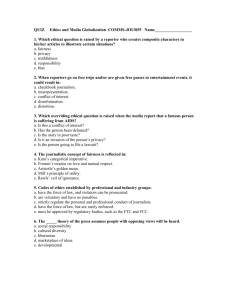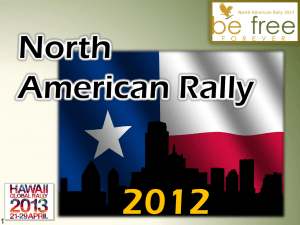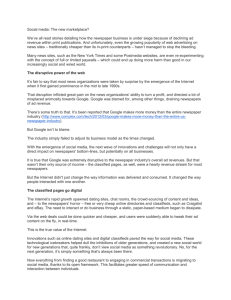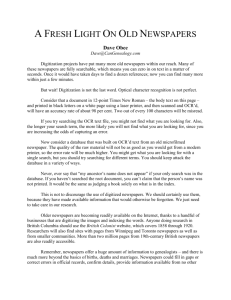NEWSPAPERS IN THE UK Due to the small geographical area of
advertisement
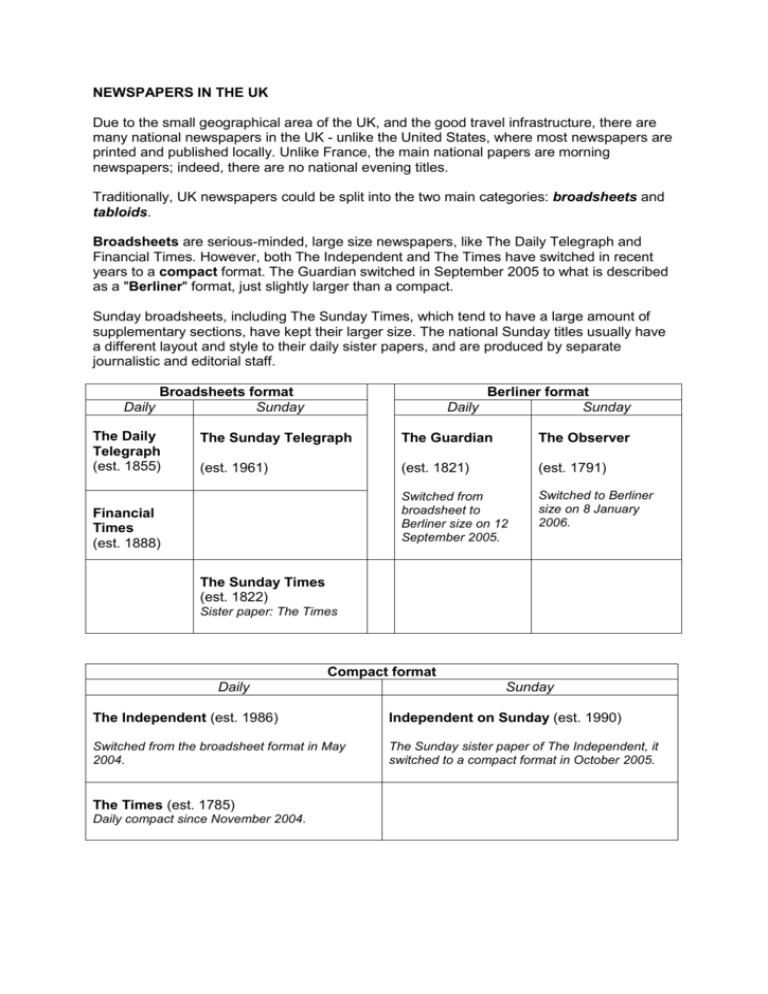
NEWSPAPERS IN THE UK Due to the small geographical area of the UK, and the good travel infrastructure, there are many national newspapers in the UK - unlike the United States, where most newspapers are printed and published locally. Unlike France, the main national papers are morning newspapers; indeed, there are no national evening titles. Traditionally, UK newspapers could be split into the two main categories: broadsheets and tabloids. Broadsheets are serious-minded, large size newspapers, like The Daily Telegraph and Financial Times. However, both The Independent and The Times have switched in recent years to a compact format. The Guardian switched in September 2005 to what is described as a "Berliner" format, just slightly larger than a compact. Sunday broadsheets, including The Sunday Times, which tend to have a large amount of supplementary sections, have kept their larger size. The national Sunday titles usually have a different layout and style to their daily sister papers, and are produced by separate journalistic and editorial staff. Broadsheets format Daily Sunday The Daily Telegraph (est. 1855) Berliner format Daily Sunday The Sunday Telegraph The Guardian The Observer (est. 1961) (est. 1821) (est. 1791) Switched from broadsheet to Berliner size on 12 September 2005. Switched to Berliner size on 8 January 2006. Financial Times (est. 1888) The Sunday Times (est. 1822) Sister paper: The Times Compact format Daily Sunday The Independent (est. 1986) Independent on Sunday (est. 1990) Switched from the broadsheet format in May 2004. The Sunday sister paper of The Independent, it switched to a compact format in October 2005. The Times (est. 1785) Daily compact since November 2004. Tabloids are less serious, sensationalist newspapers which tend to focus more on celebrity coverage and human interest stories rather than political reporting or overseas news. The tabloids in turn have been divided into the more sensationalist mass-market tabloids, or "red tops", such as The Sun and The Daily Mirror, and the middle-market tabloids, The Daily Express and The Daily Mail. “Freesheet” newspapers in urban centres Metro (est. 1999) is owned by Daily Mail and General Trust plc and is distributed for free. Wide availability in the major cities makes it the UK's 4th highest circulation paper. The Metro enjoys high circulation among users of public transport, with newspapers placed on trains and buses and distributors operating near stations. Local newspapers in England Most towns and cities in the UK have at least one local newspaper, such as the Evening Post in Bristol and The Echo in Cardiff. However, they are not known nationally for their journalism in the way that city-based newspapers in the USA are (e.g. The New York Times, The Washington Post, The Boston Globe). Online All the major UK newspapers currently have websites, some of which provide free access. The Times and The Sunday Times have a pay wall which requires payment on a per-day or per-month basis for non-subscribers. The Financial Times business daily also has limited access for non-subscribers. The Production Process Presses produce newspapers at ever-increasing speeds (86,000 copies per hour for the largest machines). The introduction of new technology into the production process streamlined and speeded the operation. Most-read newspapers in the UK (No. of readers - National Readership Survey) This shows readership, not sales, and these figures represent total adult readers of newspapers and supplements from January to December 2010. 1. The Sun 2. The Daily Mail 3. The Daily Mirror 4. Metro 5. The Daily Tel. 6. Daily Star 7. The Times 8. Daily Express 9. The Guardian 10. The Independent (7,772,000) – Mass-market tabloid (4,741,000) – Middle-market tabloid (3,087,000)* – Middle-market tabloid (3,287,000) (1,680,000) (1,571,000) (1,565,000) (1,427,000) (1,103,000) (532,000) * The Daily Mirror has a Scottish edition, the Daily Record, which has a further 884,000 readers Sources: http://www.mediauk.com/ http://en.wikipedia.org/wiki/List_of_newspapers_in_the_United_Kingdom http://www.newspapersoc.org.uk/print-technology Comprehension questions – UK Newspapers Indicate whether the following statements are true (T) or false (F). 1. 2. 3. 4. 5. There are many national evening papers in the UK. Some quality papers adopted the compact and Berliner formats because they are more popular. Middle-market tabloids are more sensationalist than mass-market tabloids. UK local newspapers are not popular on the national level. All online versions of UK newspapers provide completely free access. Answer the following questions. 1. Why are there many national newspapers in the UK? 2. What is the different between broadsheet and tabloid newspaper format? 3. How are UK Sunday titles different from their “sister” daily papers? 4. What makes Metro the 4th highest circulation paper in the UK? 5. Fill in the gaps with the correct newspaper format. Newspapers in UK No. of Lessons Grade Teachers Objectives/ Learning Outcomes Time 5 min 1 2nd Gimnazija Mojca Fink and Amresh Prakash Torul At the end of this lesson, students will be able to explain the main characteristics of British newspapers. They will also gain a solid revision of vocabulary about newspapers. Teachers activities English teacher Foreign teacher Introduction: Introduce the topic and askstudents what they know about UK newspapers. 15 min Support the explanation and provide students with Slovene translations where necessary. 15 min 10 min Instructions for handout Briefly explain to students what they should do with the handout. Then move around the classroom to help students. Feedback Check the answers with students. Write down notes on the board. PowerPoint Present the content of the PowerPoint slides prepared for the lesson. Move around the classroom to help students. Feedback/Correction Write down answers on the board. Student activities Follow introduction and participate in the short discussion. Watch the presentation and take notes if/when necessary. Work on handout Correct handouts and take additional notes. Correct answers and take notes. Evaluation Right from the start, students had the tendency to compare UK newspapers to their Slovenian counterparts. Most of them recognised the fact that Zurnal 24 is a Slovene equivalent of Metro in the UK. They also showed evidence of critical thinking by suggesting reasons explaining the popularity of this type of newspaper. The PowerPoint presentation gave the students an overview of the content covered in the handout. It was pleasing to see students taking it seriously and even pointing out some irregularities in the statistics shown by one slide. When dealing with key words about newspapers, they were comfortable and used the correct words most of the time. They did not have too many difficulties in answering the questions in the handout.


